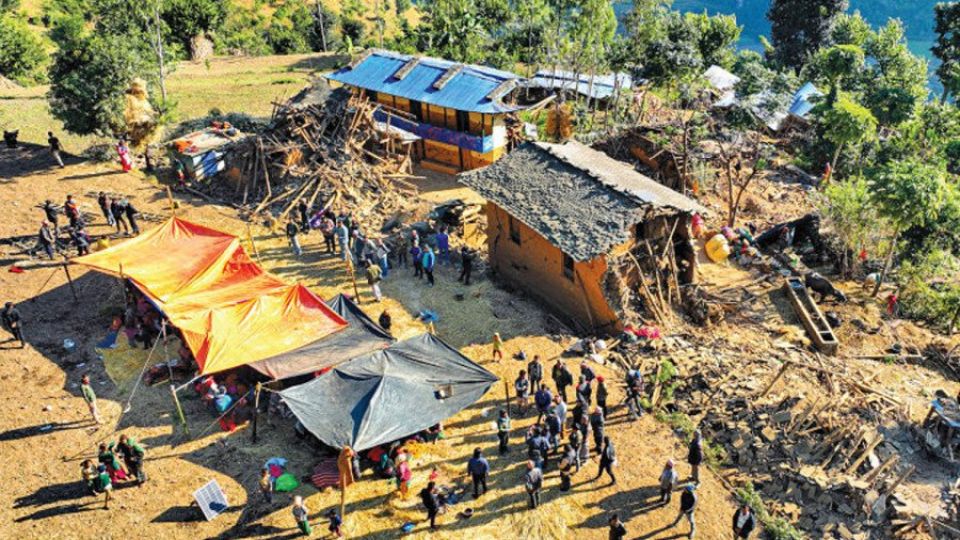February 28, 2024
KATHMANDU – When deadly earthquakes hit the country in April and May of 2015, the government tasked the National Planning Commission to conduct a detailed assessment known as Post Disaster Needs Assessment (PDNA).
The planning body also released the PDNA report as early as late June that year, which became a crucial document to start rebuilding damaged infrastructure. The earthquakes killed around 9,000 people and damaged over 750,000 private houses along with many other historical and public infrastructure.
On November 3, last year, a magnitude 6.4 earthquake that devastated Jajarkot and West Rukum districts killed 154 people and injured 366 others. As per the initial damage assessment last updated by the Home Ministry in November last year, over 62,000 housing structures, both private and public, were damaged.
But the government has yet to conduct a detailed damage assessment (DDA). “Currently, our focus is to build temporary shelters for the families affected by the three recent earthquakes in western Nepal including in Jajarkot,” said Bharat Mani Pandey, joint secretary at the National Disaster Risk Reduction and Management Authority.
“As many as 83,200 households in five districts—Jajarkot, Rukum (West), Bajhang, Bajura and Salyan—have been registered as beneficiaries for grants to build temporary shelters.”
The government has decided to provide Rs50,000 per household in two instalments based on their claims that their houses are unfit for living.
But the government is yet to start the DDA, which would be essential for rebuilding private and public infrastructure. But preparations are underway, according to the authority.
“We have prepared a draft questionnaire for the quake affected people for the DDA,” said Pandey. “We also need to prepare technical staff to conduct the assessment.”
According to him, the authority has also forwarded a draft of the working procedures on reconstruction works and the draft may soon reach the Cabinet for a final decision.
Nearly four months since the quake in Jajarkot, officials said works related to providing relief, rehabilitation of quake-affected people and building temporary shelters are being carried out.
But stakeholders are worried about possible delays in reconstruction as it is seemingly not a government priority right now.
“It is already too late to start the DDA,” said Sushil Gyewali, the chief executive officer of the then National Reconstruction Authority, (NRA), a special purpose vehicle established to coordinate reconstruction efforts after the 2015 earthquakes.
“Work on the DDA and temporary shelters should have been carried out simultaneously.”
Stakeholders say that if the assessment and reconstruction process are further delayed, there is a risk that the victims of the Jajarkot quake will be forgotten. “As time passes, the priorities of both the government and donors might change,” said Gyewali. “How long do you want to keep quake victims in temporary shelters?”
When the Israel-Hamas conflict began last October, Ukranians feared being forgotten by the world, particularly the Western countries, according to media reports. Ukraine has been fighting the Russian invasion with the backing of Western nations including the US and Europe.
“The government should have already invited donors for talks seeking their support to rebuild the houses damaged by the Jajarkot earthquake,” said Gyewali.
Given the government’s limited resources due to revenue collection falling short of target, foreign funding may be necessary for reconstruction efforts, according to stakeholders.
Govinda Raj Pokharel, former vice-chairperson of the National Planning Commission who coordinated the preparations of the PDNA in 2015, said that voices of the people affected by the Jajarkot earthquake were not getting as much attention as those affected by the 2015 quakes. “This could be perhaps because Jajarkot is far from Kathmandu,” he said.
He said that there was a real risk that the Jajarkot quake victims could be forgotten as sympathy for them continues to erode along with the time.
According to stakeholders, the DDA should be carried out immediately to fast-track reconstruction of damaged houses. “People should know how much government support they can expect and how much they should manage themselves,” said Pokharel, who also briefly headed the erstwhile National Reconstruction Authority.
“The delay in conducting the DDA will also make it difficult for the authorities to find out whether quakes and other factors were responsible for the damage caused to certain infrastructure.”


